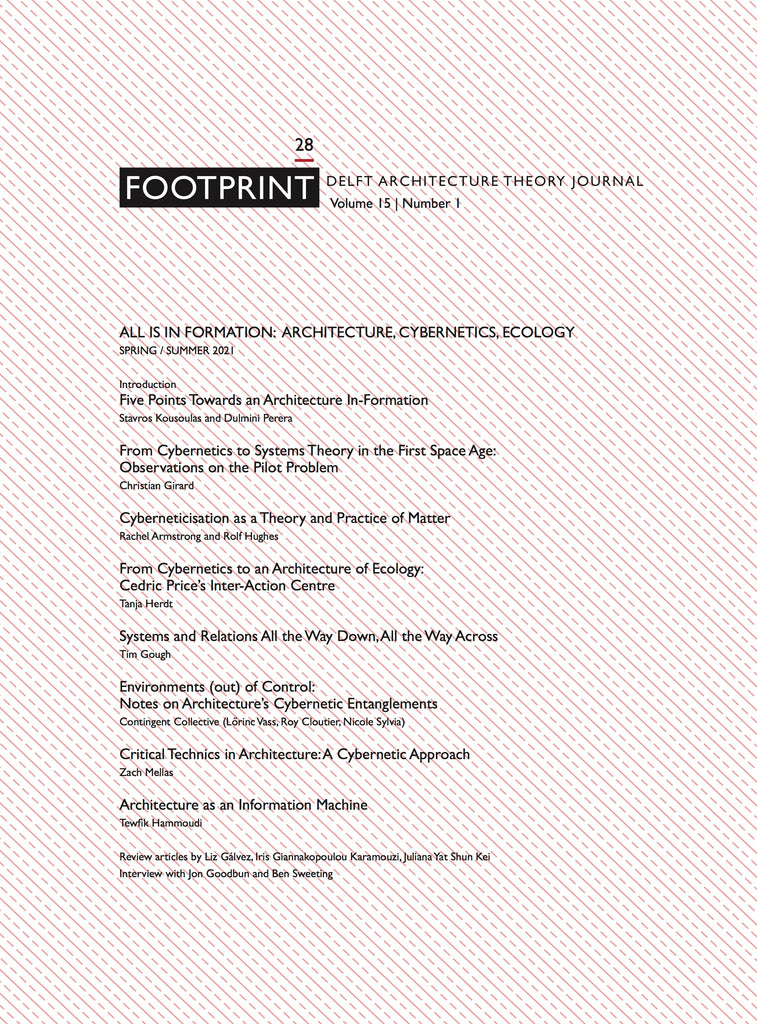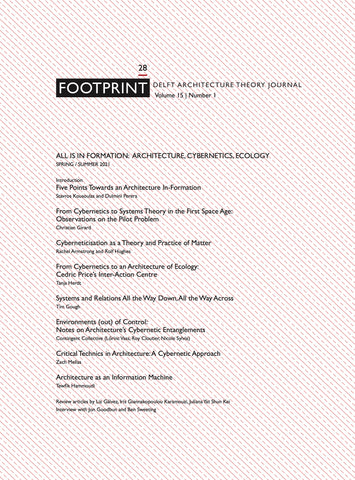Your cart is currently empty!
Bookazines / serie
Footprint 28 All is in Formation
+++Architecture, Cybernetics, Ecology+++
+++Stavros Kousoulas, Dulmini Perera [eds.]+++
978-94-92852-38-0
Lila Athanasiadou
168
19 x 25.7 cm / 7.48 x 10.12 inches
paperback
Release date: Spring / Summer 2021
English
Copy editor: Heleen Schröder
Published in cooperation with Architecture Theory Chair (TU Delft) and Stichting Footprint: http://footprint.tudelft.nl/
For a subscription: Bruil & Van de Staaij
Footprint 28 examines the relation between cybernetics and architecture by focusing on a problem they both share: the production, consumption and flow of information, or, in other terms, of meaning. Therefore, cyberneticisation can set the foundations for a relational account that examines how signs are communicated and how meaning is produced and experienced within systems. This third-order cybernetics extends beyond the original scope of living organisms and their environments in order to include ecologies of ideas, power, institutions, media and so on. In this sense, cyberneticisation is radically environmental, positing the primacy of relations over fixed terms, binary oppositions and linear logics, making it high time for architectural and urban studies to take into consideration its ground-breaking potentials.
While there have been significant discussions on the relevance of cybernetics within architectural and urban studies, focus was mainly placed on computing and digital practices. The influence of cybernetics towards formulating an alternative ecological – i.e. relational – account has been mostly neglected. However, the Anthropocene, both as a discourse and a material condition, has brought to light the need to rethink environmental histories and environmentalism in architecture beyond reductive binary logics. The once separate categories of culture and environment now give way to an ecological approach where they appear as co-constructed, providing a broader transdisciplinary circuit to explore the logics of living systems in ways that are not restricted to anthropocentrism.
Since its emergence in the post-war period, cybernetics — in both its first and second-order versions — introduced to architectural discourse systematic design methods and practices, as well as tackling issues of reflexivity and complex problems. Footprint 28 seeks to reposition cybernetics neither as an outdated way of thinking nor as computational practice, but as a discourse that continues to offer possibilities for architectural and urban design interventions. In the issue we wish to explore the encounters between architecture and cybernetics in an attempt to rethink the notion of the built environment.
To this end, Footprint 28 will approach cybernetics as the study of information, an account that has little to do with machines and digital logics. Instead, it will consider processes of cybernetisation as a generalised ecology concerned with life and the production, exchange and consumption of meaning. Therefore, cybernetisation can lay the foundations for an ecological account that examines how signs are communicated and how meaning is produced and experienced within ecological systems. This third-order cybernetics extends beyond the original scope of living organisms and their environments to ecologies of ideas, power, institutions, media, and so on. In this sense, cybernetisation is radically environmental, positing the primacy of relations over fixed terms, binary oppositions and linear logics, making it high time for architectural and urban studies to take into consideration its groundbreaking potentials.
Footprint 28 will ask who the architects and institutions are that form this extended circuit, both in its early history and currently, and will interrogate the ways in which they attempt to reconceptualise the built environment. The issue will focus on the core concepts that emerge from the interaction between architecture and cybernetics, especially in the context of generalised ecology: What is their effect on design methods and practices? Does their theoretical influence surpass their practical application? How are design education and pedagogy shaped by cybernetics? How are concepts and methods that emerge from these discourses used to deal with complex contemporary environmental problems?
Architecture, Cybernetics, Ecology
€25.00
Footprint 28 All is in Formation
Architecture, Cybernetics, Ecology
€25.00
Architectuur / Bookazines / serie / Theorie / Stedenbouw
978-94-92852-38-0
Lila Athanasiadou
168
19 x 25.7 cm / 7.48 x 10.12 inches
paperback
Release date: Spring / Summer 2021
English
Copy editor: Heleen Schröder
Published in cooperation with Architecture Theory Chair (TU Delft) and Stichting Footprint: http://footprint.tudelft.nl/
For a subscription: Bruil & Van de Staaij
Footprint 28 examines the relation between cybernetics and architecture by focusing on a problem they both share: the production, consumption and flow of information, or, in other terms, of meaning. Therefore, cyberneticisation can set the foundations for a relational account that examines how signs are communicated and how meaning is produced and experienced within systems. This third-order cybernetics extends beyond the original scope of living organisms and their environments in order to include ecologies of ideas, power, institutions, media and so on. In this sense, cyberneticisation is radically environmental, positing the primacy of relations over fixed terms, binary oppositions and linear logics, making it high time for architectural and urban studies to take into consideration its ground-breaking potentials.
While there have been significant discussions on the relevance of cybernetics within architectural and urban studies, focus was mainly placed on computing and digital practices. The influence of cybernetics towards formulating an alternative ecological – i.e. relational – account has been mostly neglected. However, the Anthropocene, both as a discourse and a material condition, has brought to light the need to rethink environmental histories and environmentalism in architecture beyond reductive binary logics. The once separate categories of culture and environment now give way to an ecological approach where they appear as co-constructed, providing a broader transdisciplinary circuit to explore the logics of living systems in ways that are not restricted to anthropocentrism.
Since its emergence in the post-war period, cybernetics — in both its first and second-order versions — introduced to architectural discourse systematic design methods and practices, as well as tackling issues of reflexivity and complex problems. Footprint 28 seeks to reposition cybernetics neither as an outdated way of thinking nor as computational practice, but as a discourse that continues to offer possibilities for architectural and urban design interventions. In the issue we wish to explore the encounters between architecture and cybernetics in an attempt to rethink the notion of the built environment.
To this end, Footprint 28 will approach cybernetics as the study of information, an account that has little to do with machines and digital logics. Instead, it will consider processes of cybernetisation as a generalised ecology concerned with life and the production, exchange and consumption of meaning. Therefore, cybernetisation can lay the foundations for an ecological account that examines how signs are communicated and how meaning is produced and experienced within ecological systems. This third-order cybernetics extends beyond the original scope of living organisms and their environments to ecologies of ideas, power, institutions, media, and so on. In this sense, cybernetisation is radically environmental, positing the primacy of relations over fixed terms, binary oppositions and linear logics, making it high time for architectural and urban studies to take into consideration its groundbreaking potentials.
Footprint 28 will ask who the architects and institutions are that form this extended circuit, both in its early history and currently, and will interrogate the ways in which they attempt to reconceptualise the built environment. The issue will focus on the core concepts that emerge from the interaction between architecture and cybernetics, especially in the context of generalised ecology: What is their effect on design methods and practices? Does their theoretical influence surpass their practical application? How are design education and pedagogy shaped by cybernetics? How are concepts and methods that emerge from these discourses used to deal with complex contemporary environmental problems?







